|
0 Comments
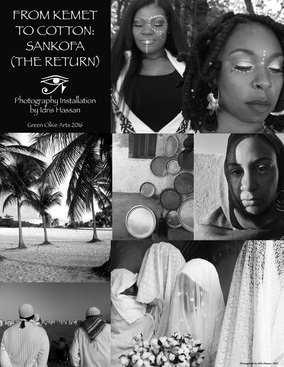 DAY FOURTEEN (September 25, 2016) Today I finish my installation and hang my photographs for my exhibition "From Kemet to Cotton". Working on this project has been both emotional and uplifting. Being here in Afrika has brought up a lot for me around identity, culture, and healing. On this project I have utilized the diverse range of my creative talents from sewing to painting, and from digital editing to glue gun adhesion. The lack of frames and having to present work without being able to nail into the walls has forced me to stretch creatively. "From Kemet to Cotton" highlights the MAAFA (a Ki-Swahili word, meaning "Great Disaster", used to describe the Trans-Atlantic Slave Trade) experience in art form and is an honoring for the Ancestors lost. This exhibition is designed to be an educational and healing experience for the people of Morocco, and the process of creating it has been a deeply healing and educational one for myself. (Ase) 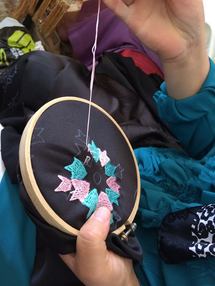 DAY ELEVEN (September 22, 2016) On this day I embark on an "Artisan Tour" with the Green Olive staff to witness first hand how many of the traditional ceramics, wood carving, metal work, painting, embroidery, and weaving are done by the local artisans in Tetouan. Beautiful craftwork is found everywhere in Tetouan as it is embedded in the everyday fabric of life. For many of the artisans their craft has been passed down from generation to generation. Almost all of the craft work requires detailed knowledge of math and in particular "Sacred Geometry." I stand in awe watching the rug makers tie the single knots of thread that will become a full tapestry, weavers making beautiful wraps on a traditional loom, and leather makers tapping intricate designs into handbags, as well as engravers who spend the day chiseling out beautiful designs on brass trays. We visit the "Tetouan Fine Arts Preparatory School", which was established by Mariano Bertuchi, a Granadan painter and arts educator, in 1945. Some of the young artisans begin their training in the 4 year program as young as 10 years of age. The program also serves to support some of the young people who experience difficulty in traditional schooling. They excel as artisans as they move through basics then choose to specialize in one of the fine crafts. The time and mastery that goes into the craft work deserves true respect. In a time of advanced machinery and technology it is humbling to know that there are still places in the world where true craftsmanship is preserved and passed on. 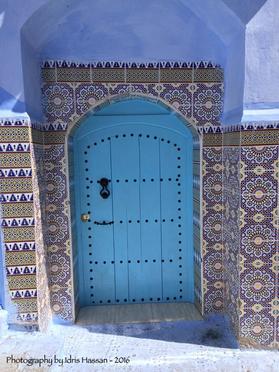 DAY TEN (September 21, 2016) I must say that thus far my visit to the city of Chefchaouen (pronounced Chef-Sha-Wen) has been a amazing highlight. The older part is known as the "Blue City" and is about 1 hour away from Tetouan by taxi. The roads are curvy as we travel the base of the Rif Mountains. Here people still create in a traditional way. They make bread and bring it to the baker to cook. They can be seen in their shops crafting, by hand, leather shoes and bags; weaving beautiful tapestries; taping out intricate designs on brass trays; carving wooden boxes and honey-dippers, and painting amazing images of the "Blue City" right there on the spot. I bow my head to these craftsmen and women who are daily making these intricate wears and maintaining long-standing art traditions. People come to Chefchaouen from all over the world. Some people here think I am Arib-ee (as they say) or Moroccan. I believe it is my ancient connection to this land of Africa (A-free-ka) that they see in me and I am deeply humbled to be seen as one of their own. 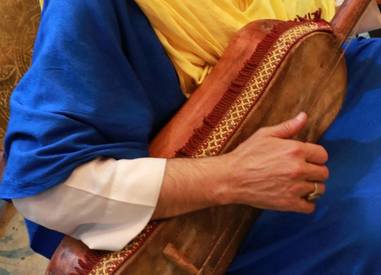 DAY TEN (September 21, 2016) - Part II As this is somewhat of tourist destination more of the merchants here speak english so I am able to communicate in greater depth with some of the locals. As I go exploring the blue medina in search souvenir gifts an Amazigh (Pronounced A ma-zien) elder beckons to me as I walk past …"Sister, come into my shop" he says. The shop is filled with beautiful wears and trinkets, and his amazing paintings. The elder, wrapped in a yellow turban and a beautiful blue Moroccan robe, is from the ancient desert culture of the Amazigh people. "You look like a Berber (Amazigh) woman" he tells me. "Where are you from he asks?" I tell him, then when I tell him my name and then my father's Arabic name, he is pleased. He then blesses me with a prayer, takes my right hand and kisses it four times, then kneels at my feet and prays for me. He then begins to share the history of his ancient people. "I come here to sell my wears part of the year, then part of the year I go back to my people in the desert," he tells me. "In the desert we believe in nature, the Chakras, and that all people are from the root of the same tree." I nod and soak it in. "Let me play a song for you," and he begins to plays a magical song on a traditional Amazigh guitar. He allows me to take a few pictures, which he says he never does for tourists, as on an occasion one from Europe took his image without permission (with a pair of Google glasses) and won 7000 euros in a photo contest for it. I purchase some wears from his shop and he leaves me with a message…"You are a blessed spirit with a good heart, stay on the right path"…I leave feeling honored and blessed by his words. 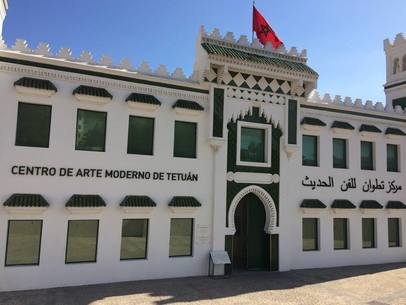 DAY NINE (September 20, 2016) Morocco is a city full of amazing art and artisans. Today I venture out to visit the "Centro De Arte Moderno De Tetuan" (The Tetouan Center of Modern Art). The center is "considered to be one of the most important symbols of Spanish-Moroccan and Andalusian-Tetouani cooperation and common memory." The work of Mariano Bertuchi, a Granadan painter and arts educator, is central to the museum. He established the "Tetouan Fine Arts Preparatory School" in 1945, which presently continues to train young artisans in traditional crafts. This center has four main sections displaying art work by student artist from various eras. The Museum, housed in an renovated railway station, is supported by the Culture Ministry of the Kingdom of Morocco. I am especially moved by the original of Bertuchi's masterful work capturing a scene of a Moor-ish desert camp, entitled "Corrida de la polvora vista desde la tienda del Bedunio". (A replica hangs at the Tetouan Department of Tourism). It is wonderful to see the evolution of Bertuchi's students through the years as they perfect then experiment with different techniques and then influence of international cultures in their work in later years. Their creative and masterful use of color, texture, and style is highly inspiring. On this day I also attend an amazing art reception at the newly established "Galerie Du Centre Socio-Culturelle De Tetouan" for the opening of a show entitled "Visions Plurielles", which features 17 contemporary and classic Moroccan artists. The school was established this year to further support the education of artists in Tetouan. The diversity of style and technique is an visual assault of Moroccan color, texture, tradition, and experimentation. My favorite piece is "Poupee de feu" (2016) by Abdelhamid Benali. 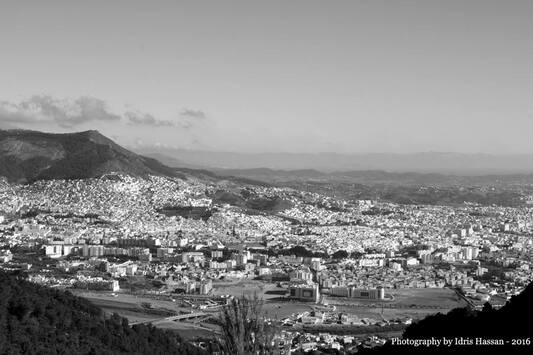 DAY SIX (September 17, 2016) On this day I venture on a hike with the Green Olive Arts staff members, along with their family and friends, and the other GOA resident artist. The Rif Mountains are ancient. Indigenous people of the region traveled and lived in these mountains. The Rif Mountains, in Arabic Al-Rif, mountain range of northern Morocco, extends from Tangier to the Moulouya River valley near the Moroccan-Algerian frontier. The Amazigh tribes led by Abd el-Krim (1882–1963) resisted Franco-Spanish occupation there in the 1920s. The view of the City of Tetouan from the mountain is amazing. The Straits of Gibraltar, the Mediterranean Sea, and the tip of Spain can be seen from the top. Herdsmen move through the area with their baby goats, as sheep dogs bark out warnings of our approach. The air is crisp and clean. I take deep breaths, feeling grateful and refreshed by the beauty of this natural world. 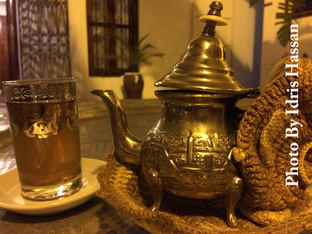 DAY THREE (September 15, 2016) After almost two days of sleep and jet-lag recovery I begin to venture out into the city. Tetouan City (Pronounced Tet-Won) is known as the "White Dove", a symbol of peace. The city, with its buildings painted mostly in white, is rich in cultural diversity and beautiful food. The cultural heritage comes from an intersection of the original people of this region who hail from the Andalusian area and the influx of African, Spanish, and Arab populations. The French referred to the original people as "Berber", which means Barbarian in French, however the people refer to themselves as "Amazigh" (Pronounced Ama-zien). Here they speak a dialect of Arabic known as " Derija". It is a challenging language for me, but I am learning a few words and phrases that will allow me to interact with the locals better. Evening is when the citizens come out for tea, shopping, and conversation; Men dominating the coffee shops with Women interacting mainly during home visits. The King's palace in Tetouan is beautiful at night as lights brighten the beautiful Moroccan Coat of Arms. 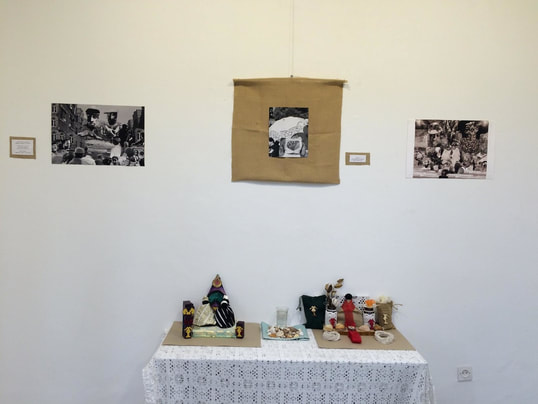 DAY FOUR (September 15, 2016) Feeling energize I begin to let the creative process flow. Much of my art work centers on cultural documentation, particularly as it pertains to the Afrikan Diaspora. My residency culminates in an exhibition of my photography work, yet the challenge in presenting my work here in Morocco has been the inability to bring frames to display my photography. They are too costly to ship, too bulky to travel with, and the shops have a minimal selection. However, the Green Olive Arts center has many unique materials on hand for the various artists that visit the space. So I have decided instead to create an installation using fabric for framing and wood for mounting photos. One piece I am working on is entitled "From Kemet to Cotton", which pays tribute to those lost to the MAAFA (a Ki-Swahili word, meaning "Great Disaster", used to describe the Trans-Atlantic Slave Trade) experience in art form. Being here in Afrika I want this exhibition to be an educational and healing experience for the people of Morocco.  DAY ONE (Sept. 12, 2016) I arrive in Morocco during the celebration of the Eid Kebir (The "Festival of the Sacrifice"). I also arrive to the Tangier Airport at the same time as the King of Morocco. Shops are closed and the usually busy streets are mostly empty. The route we take to Tetouan is lined with large, beautiful Moroccan flags. Service men are stationed along the road to salute the passing King who is following some miles behind us. Sheep are the sacred meat of the Eid Kebir. Many Moroccons carry the empty sheep skins on various forms of transportation…cars, motorcycles, wheel barrows…to be transformed into leather wears. As we arrive in Tetouan the smell of smoking sheep engulfs the city. The people are in their homes butchering and cooking their celebratory meal and after a very long journey I have a delicious Moroccan meal at the El Reducto Restaurant in the Medina. As-salāmu ʿalaykum |
Photo by Rachel Pearcy of GOA
AuthorIdris Hassan Archives
October 2016
Categories |

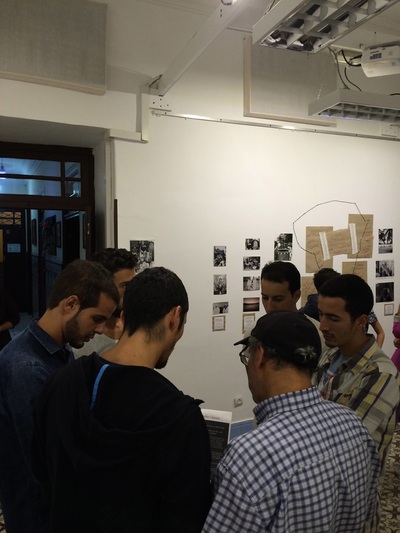
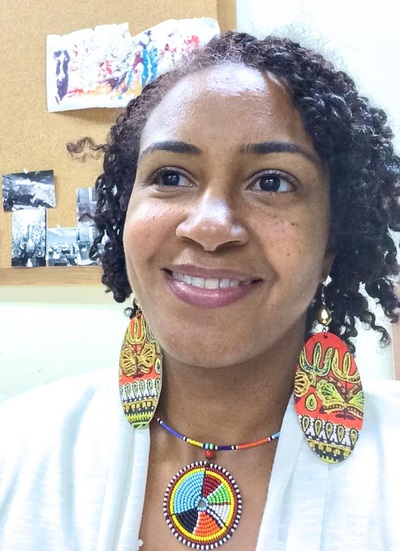
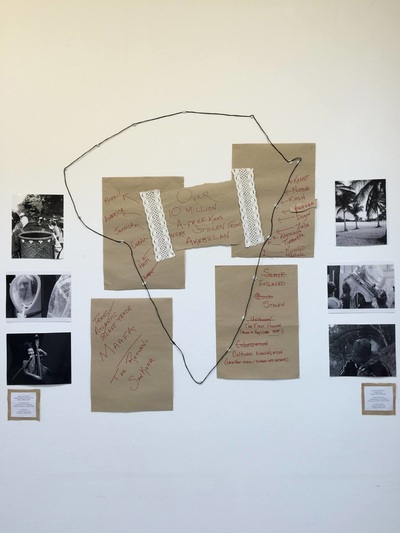
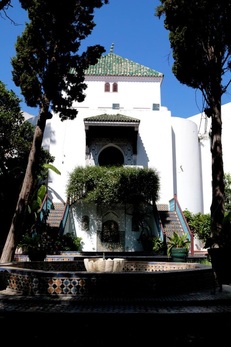
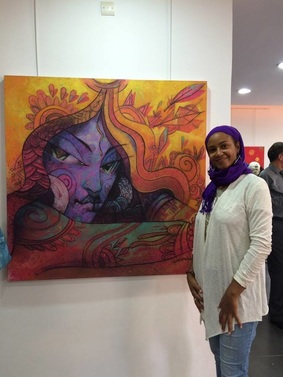
 RSS Feed
RSS Feed
